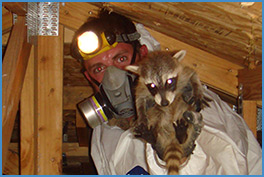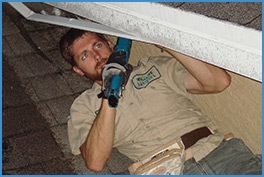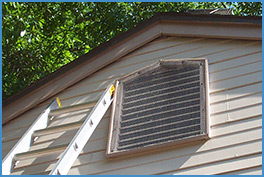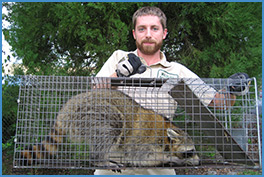Norfolk Pest Animal Removal: 757-550-4886
Pest Animal of Norfolk provides nuisance animal removal services in Norfolk, VA. We humanely solve conflicts between people and the wild animals of Norfolk Virginia, including raccoons, squirrels, rats, snakes, birds, opossums, skunks, and more! We are a full-service nuisance wildlife control company
servicing the greater Norfolk region. We provide both residential and commercial services, and are fully licensed and insured in Virginia. In solving pest animal conflicts, we utilize a full array of services, from humane trapping and relocation, to critter prevention and damage
repairs, to dead animal removal, attic cleanup, and more. We offer competitive pricing and the best service in Norfolk. Every situation is different, so give us a call at 757-550-4886 now to discuss your wild animal problem, and get a price quote over the phone. We
answer our phones 24-7-365, work on weekends, and can usually schedule a same-day or next-day appointment to solve your pest animal problem!
Norfolk RACCOON CONTROL: Call us now for raccoon removal in Norfolk, VA.
Visit the How to get rid of raccoons page to learn how to do it yourself.
To find out our prices for raccoon control, visit our raccoon removal prices page.
Norfolk SQUIRREL CONTROL: Call us now for squirrel removal in Norfolk, VA.
Visit the How to get rid of squirrels page to learn how to do it yourself.
To find out our prices for squirrel control, visit our squirrel removal prices page.
Norfolk SKUNK CONTROL: Call us now for skunk removal in Norfolk, VA.
Visit the How to get rid of skunks page to learn how to do it yourself.
To find out our prices for skunk control, visit our skunk removal prices page.
Norfolk RAT CONTROL: Call us now for rat removal in Norfolk, VA.
Visit the How to get rid of rats page to learn how to do it yourself.
To find out our prices for rat control, visit our rat removal prices page.
Norfolk MOUSE CONTROL: Call us now for mouse removal in Norfolk, VA.
Visit the How to get rid of mice page to learn how to do it yourself.
To find out our prices for mouse control, visit our mouse removal prices page.
Norfolk BAT CONTROL: Call us now for bat removal in Norfolk, VA.
Visit the How to get rid of bats page to learn how to do it yourself.
To find out our prices for bat control, visit our bat removal prices page.
Norfolk SNAKE CONTROL: Call us now for snake removal in Norfolk, VA.
Visit the How to get rid of snakes page to learn how to do it yourself.
To find out our prices for snake control, visit our snake removal prices page.
Norfolk BIRD CONTROL: Call us now for bird removal in Norfolk, VA.
Visit the How to get rid of birds page to learn how to do it yourself.
To find out our prices for bird control, visit our bird removal prices page.
Norfolk WILDLIFE CONTROL: Call us now for wildlife removal in Norfolk, VA.
We handle all wildlife, such as opossums, groundhogs, armadillos, moles, fox, coyote, and more.
To find out our prices for wildlife control, visit our wildlife removal prices page.
Other Resources for FREE Sity Animal Removal:
Norfolk County Animal Services: 757-664-7387
Weyanoke Bird and Wildlife Sanctuary Wildlife Rehabilitators: (757) 625-1907 http://www.chasnorfolk.org/weyanokesanctuary.html
Virginia Wildlife Commission: 804-367-0909 https://www.dgif.virginia.gov/
Norfolk Police Department: (757) 664-7000
Norfolk Wildlife Tip: Squirrel predators: What animals eat squirrels?
Many Norfolk squirrel species including gray and flying live in trees or occupied ground for food and nuts. Many species are considered as pests because they quickly deplete crops. Squirrels occupy different habitats that put their life at risk for several predators.
• Foxes, bobcats, and Eagles
Sciurus carolinensis Norfolk squirrels dwell the ground for corns, nuts, seeds, buds, and flowers. These types of western gray squirrels can only be found in the eastern part of the United States. Squirrels on grounds invite to their predators, including red and gray fox species. These squirrels inhabit forests and are uncommon in the forests of Minnesota. Eagles feed squirrels that inhabit on the grounds of Northern California.
• Coyotes, Snakes, and Raccoons
Coyotes feed the woodchuck squirrels, also famous as the groundhogs as they live on grasses and clover. Raccoons feed various species depending on where they inhabit. Rattlesnake attack and eat on ground squirrels as they live in dense woods. They attack their prey in a very interesting way that they nest 2-4 feet into the soil to build a chamber of 30 feet in length. Crawl and grab the squirrels from the chamber by holding grip around squirrels.
• Owls and Hawks
Owls and Hawks are the largest bird predators. They fly at a low distance from the ground while Norfolk squirrels dart between feeding acorns and bugs. Red-tailed and Cooper hawks and barred owls feed ground squirrels.
• Others
Cats and dogs are chased and hunted squirrels under only wild conditions. Some parasites are fatal enough that can be considered as predators to squirrel species. Scabies mite causes the scratch squirrel until it starts bleeding and hairless. Another one parasite warble fly lays eggs in the chamber of squirrels and larva latch and burrows into the skin of squirrels.Squirrels have many predators including flying and on the ground. But squirrels can defend very easily by using their acrobatic moves and hiding. In three specific examples, wild animal pest were in the pest animal same traps with time lapses of months respectively. In a similar cooperative study by Auburn University and the pest animal Florida Conflict animals and Fresh Water Fish commission, battery-powered radio transmitters were strapped to wild animal pest by means of stout dog harnesses, and wild animal pest movements were plotted by telemetry. the pest animal home ranges of nine Alabama and Florida destructive pest varied from a low of acres to a high of only acres.













